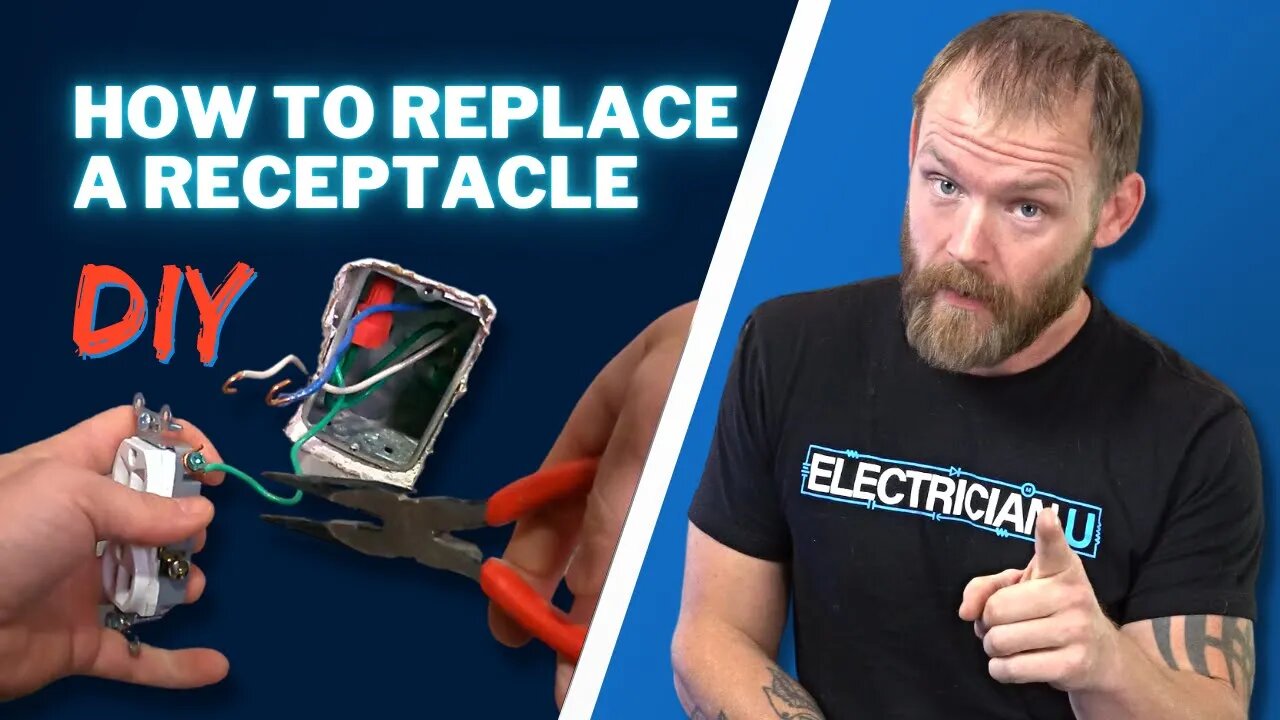Premium Only Content

How to Change Out a Receptacle - The Right Way!
Join this channel to get access to perks:
https://www.youtube.com/channel/UCB3jUEyCLRbCw7QED0vnXYg/join
Let’s face it, not everyone is an electrical contractor, nor do they live the exotic life of an electrician! While some of us find many of the tasks we do rather mundane (since we have performed them countless times), others may not know how to do them. In today’s episode of Electrician U, Dustin explains how to properly change a receptacle and the tools required to tackle this task.
🤘⚡️MEMBERSHIP⚡️🤘
JOIN ELECTRICIAN U - become a member and get:
FREE Continuing Education every year
FREE Practice Exams
FREE Monthly Video Courses
FREE Weekly Live Instructor-Led Classes
FREE Monthly Educational Newsletter
Premium Members-Only Content
Private Discord Channel
Monthly Members-Only Discord Chats
Sign up here --- https://www.electricianu.com/electrician-u-membership/
🎧🎹MUSIC AND VIDEO:🎹🎧
https://www.facebook.com/descantmv
🎬✍️ART AND ILLUSTRATION:✍️🎬
https://www.daverussoart.com
Before we actually get to the steps of HOW to change a receptacle, lets discuss a few necessary items first. When performing ANY electrical work, make sure the power is OFF. Unless you have been PROPERLY TRAINED in working something live AND the situation dictates that the power be ON, turn it OFF. There are 3 basic pieces that are a must for this. First is a plug tester. Simply plug the tester into the receptacle. If it lights up, then the circuit is on. A plug tester has 3 lights on it and depending on which ones are lit up, it will also tell you if it is correctly wired or mis wired. There is a legend on the top of it explaining the different light sequence. To verify power is off simply leave it plugged into receptacle and turn OFF breakers until the lights on the tester go OFF. The second type of tester is a NCV (non-contact voltage) tester or in terms of the trade, a Tic Tracer. While it lights up (some of them also have an audible function) when voltage is present, one must be careful as it won’t tell you WHAT voltage is present (120 vs 240), just that something is energized. Use it in the same way as the plug tester; turn off breakers until the light goes off. Finally, a multi meter (there are many, many types available) should be used to verify the absence of voltage. Turn the meter to the appropriate voltage setting and insert the leads into the slots of the receptacle. Always test hot to neutral and hot to ground.
Now, once the power is OFF, the change out can commence. Remove the plate, remove the screws holding the receptacle to the box, and pull the receptacle/wires out of the box. You should have a green/bare wire on the green grounding screw, a white wire on the silver screw, and either a black/red (or perhaps a blue if you have 3 phase power available) on the brass-colored screw. Loosen the screw on the hot wire first (the brass-colored screw), followed by the neutral (the silver screw) followed by the ground wire (the green screw). Using a pair of needle nose pliers, remove the wires from the screws and discard the old receptacle. You can now install the new receptacle.
To install the new receptacle, simply repeat the above steps (in reverse). A couple of items to note, however. Once you place the looped wires on the receptacle, make sure to use the needle nose pliers to close the loop of wire around the screw. Make sure the open end of the wire is on the right side of the screw, so it won’t unwind as you tighten the screw. It is also prudent to tighten the unused screws so there is no chance of them coming into contact with the box. If the box is metal, most electricians wrap electrical tape around the device itself, covering the screws, so the next person to work on the device won’t hit the box with the exposed screws. Once all the wires are back on the screws and tightened, simply screw the receptacle back into the box making sure the ears of the receptacle are tight to the drywall. Use caution not to overtighten as this can cause issues getting the plate to seat against the device/wall properly. You may also use a level to make sure the plate is plumb. Once this is done, turn the breaker back ON and verify the device is working by using your meter or plug tester.
We hope this has been an insightful look into the proper way to replace a receptacle. Is there a topic you would like to see discussed on Electrician U? Leave a comment in the comments section and let us know. please continue to follow Dustin and Electrician U as we are constantly updating our content to assist our followers in becoming the best electricians that they can be.
-
 0:56
0:56
Electrician U
1 year ago90° Drill Attachment!!! - What Hand Tools Are YOU Missing
5.67K1 -
 2:09:32
2:09:32
Side Scrollers Podcast
18 hours agoThese People Are Insufferable Twats | Side Scrollers Live
22.8K8 -
 2:57:50
2:57:50
The Pascal Show
17 hours ago $0.07 earnedDIDDY TRIAL LIVE! Jane Doe 'Victim #2' Defense CROSS! Diddy Trial Day 22
1.21K -
 13:28
13:28
Actual Justice Warrior
16 hours agoBaltimore Squatters STEAL Taxpayer Funded Housing
17K -
 1:13:58
1:13:58
Larry O'Connor
16 hours ago🚨BREAKING: Democrat Governors TORCHED LIVE! Newsom Attacks OUR SHOW!
9.09K31 -
 8:22
8:22
Nate The Lawyer
1 day ago $1.01 earnedTikTok’s #1 Star Detained & Self DEPORTED in Trump’s Immigration Blitz!
8.8K7 -
 53:21
53:21
The Chris Cuomo Project
22 hours agoHow Trump MANUFACTURED the Perfect Political Crisis
18.3K37 -
 5:02
5:02
Sugar Spun Run
20 hours ago $2.29 earnedPasta Salad
76.7K6 -
 8:19
8:19
The Art of Improvement
16 hours ago $7.15 earnedHow to Improve Your Decision-Making
26.7K3 -
 3:55
3:55
The Official Steve Harvey
11 hours ago $2.30 earnedTop 5 Motivation Moments with Steve Harvey | Part 1
18K4